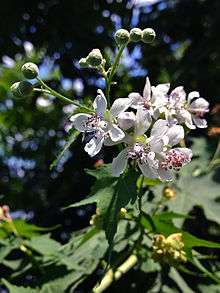Sida hermaphrodita
| Sida hermaphrodita | |
|---|---|
 | |
| Scientific classification | |
| Kingdom: | Plantae |
| (unranked): | Angiosperms |
| (unranked): | Eudicots |
| (unranked): | Rosids |
| Order: | Malvales |
| Family: | Malvaceae |
| Genus: | Sida |
| Species: | S. hermaphrodita |
| Binomial name | |
| Sida hermaphrodita (L.) Rusby | |
| Synonyms | |
Sida hermaphrodita, known by the common names Virginia fanpetals and Virginia mallow, is a perennial forb native to the eastern United States,[3] which produces white flowers in summer.
Description
_Rusby_Virginia_fanpetals.tiff.jpg)
The branching stem of Sida hermaphrodita is 1 to 4 meters tall, and up to 3 centimeters in diameter. The leaves are 10 to 20 centimeters long and borne on petioles. The leaves are simple, but palmately cleft into 3 to 7 lanceolate lobes. The flowers are borne in terminal clusters. Each flower has 5 petals, which are about a centimeter long. The fruit is a schizocarp that splits into segments when ripe.[4][5][6]
Distribution and habitat
Sida hermaphrodita has been recorded in Washington, D.C., Indiana, Kentucky, Massachusetts, Maryland, Michigan, New Jersey, New York, Ohio, Pennsylvania, Tennessee, Virginia, West Virginia, and the Canadian province of Ontario, although local distribution may be spotty. It is listed as an endangered species by the states of Indiana, Maryland, Tennessee, and Pennsylvania, and as a species of special concern by Kentucky.[3] In Virginia, Sida hermaphrodita grows in habitats such as sandy or rocky river shores.[7] The presence of this species is dependent on appropriate habitat, and it may be eliminated from an area by development, changes in land use, or competition with invasive species.
Taxonomy
Recent phylogenetic research confirms that Sida hermaphrodita is not particularly closely related to other members of the genus Sida. Over the years, it has been suggested that this species might be closer related to the monotypic genus Napaea, or to Sidasodes, a genus of two species native to the Andes, however, further research has not supported either of these relationships. If Sida hermaphrodita is to be transferred to another genus, it is not clear which it should be.[8]
In cultivation
In Poland, Sida hermaphrodita is grown for its fiber, as a source of fodder for livestock, and as a source of nectar for beekeeping. It is currently being investigated as a source of biomass for alternative energy production purposes.[6][9]
References
- ↑ Sida hermaphrodita NatureServe
- ↑ "Sida hermaphrodita (L.) Rusby - The Plant List". Retrieved January 24, 2014. The Plant List (2013). Version 1.1. Published on the Internet; http://www.theplantlist.org/
- 1 2 "Plants Profile for Sida hermaphrodita (Virginia fanpetals)". Retrieved February 14, 2014. USDA, NRCS. 2014. The PLANTS Database (http://plants.usda.gov). National Plant Data Team, Greensboro, NC 27401-4901 USA.
- ↑ Britton, Nathaniel Lord & Brown, Addison (1913). An Illustrated Flora of the Northern United States, Canada and the British Possessions: From Newfoundland to the Parallel of the Southern Boundary of Virginia, and from the Atlantic Ocean Westward to the 102d Meridian, Volume 2., p. 520. Charles Scribner's Sons, New York.
- ↑ "Sida hermaphrodita (Virginia fanpetals): Go Botany". Retrieved February 14, 2014. Copyright © 2011-2013 New England Wild Flower Society (http://www.newenglandwild.org)
- 1 2 Marta Oleszek, Mariusz Matyka, Justyna Lalak, Jerzy Tys, and Ewelina Paprota (2013) "Characterization of Sida hermaphrodita as a feedstock for anaerobic digestion process" (PDF). Retrieved February 14, 2014. Journal of Food, Agriculture & Environment Vol.11 (3&4). WFL Publisher. Helsinki, Finland. (http://world-food.net)
- ↑ "Digital Atlas of the Virginia Flora | Sida hermaphrodita (L.) Rusby". Retrieved February 14, 2014. Virginia Botanical Associates. (2014). Digital Atlas of the Virginia Flora (http://www.vaplantatlas.org). c/o Virginia Botanical Associates, Blacksburg.
- ↑ Javier Fuertes Aguilar, Paul A. Fryxell, Robert K. Jansen "Phylogenetic Relationships and Classification of the Sida Generic Alliance (Malvaceae) Based on nrDNA ITS Evidence". Retrieved February 17, 2014. Systematic Botany, 28(2):352-364. 2003. The American Society of Plant Taxonomists.
- ↑ H. Borkowska, R. Molas, A. Kupczyk (2009) "Virginia Fanpetals (Sida hermaphrodita Rusby) Cultivated on Light Soil; Height of Yield and Biomass Productivity" (PDF). Retrieved February 14, 2014. Polish Journal of Environmental Studies. Vol. 18, No. 4. (http://www.pjoes.com)
